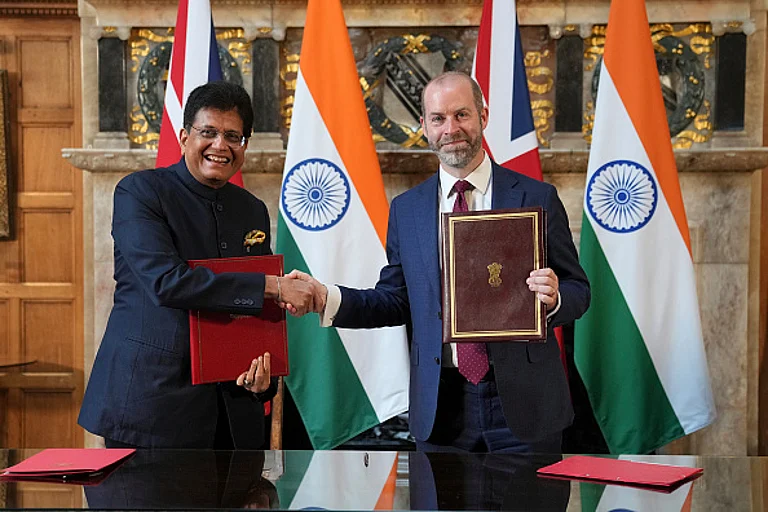- To Beginnings: Uber and Ola introduced cab services at throwaway prices for an increasingly smartphone savvy urban pop.
- Cab cartel: After sidelining all possible competition, the companies started hiking prices over carefully calculated demand.
- The Ear pull: Finally, the Delhi High Court prohibited the ‘surge price’ policy of the taxi aggregators.
***
For Apurva Bhatiya, a resident of Nehru Place, Delhi, taking a radio taxi to work in Connaught Place was a better option than driving his own car. He rarely ever minded taking the taxi for a higher price or ‘surge pricing’ during peak hours as long as he was assured of a ride to work. Recently, a Delhi High Court order, which came into force on August 22, curbed surge pricing for radio taxis—but now, barely any taxi is available in the area. Neha Ghai of Bangalore, on the other hand, is thrilled about the sudden reduction in prices. Scouring for autos most days because of surge pricing, she now has the option of calling a radio cab instead.
The debate over surge pricing by taxi aggregation companies such as Ola and Uber is a long-drawn one. In fact, it is a global issue, one that has sparked off protests even in cities like Paris and New York. In India, the recent judgements by the Delhi and Karnataka high courts banning the practice of surge pricing has set in motion a nationwide attack on the profit-maximising practice. As far as India is concerned, surge pricing is on the way out. How will this affect the consumers, the companies, the drivers—indeed the entire ecosystem that has boomed in recent years—that’s the question everyone’s asking.
It has been just two years since multinational giant Uber and its Indian competitor Ola entered the city transport scene in India. The business model had never been tested before in the country. With no government regulations in place, the companies set their own rules and blithely proceeded to undercut competition in a race to capture the market. Their growth was very rapid as commuters were enamoured by their lower pricing compared to other players, including autos and government-registered radio taxis, which have to follow the rules such as fare rates fixed by the different city authorities.
The state governments were soon forced to step in to check radio taxis with the traditional taxi and auto operators voicing protests. “The kinds of Uber and Ola are already profitable in many developed countries like the US,” says Indrajit Gupta, co-founder and director of Founding Fuel. “They've used surge pricing to not only help drivers in their network make more money, but also presumably to recoup some of their huge losses,” he adds.
Despite repeated requests, Uber and Ola did not respond to Outlook’s questions on the clampdown on surge pricing. In general, they claim it is an imperative part of their model as it incentivises drivers to be on the road during peak hours, thereby enabling them to expand their fleet. This, of course, is set to change as the Delhi government has drafted a policy to regulate these companies. And it seems to have clicked with the court. “After going through the policy, the high court decided that it needed to increase the ambit of regulations to a national level,” says Delhi transport minister Satyendar Jain. “The high court has already constituted a central committee, which includes the central environment secretary, the central transport secretary and the Delhi transport secretary to increase the ambit of the draft to a national level.”
Soon after the Delhi High Court order, the Karnataka government too followed suit by banning surge pricing in the state and restricting prices to Rs 19.5 per km for all radio taxis. As Ola grows in other cities, states like Tamil Nadu and Telangana have been in talks with stakeholders to curb surge pricing.
India is not the first country where Uber has come under the radar over its surge pricing. Regulations have been put in place in Paris and New York to curb the practice. The taxi aggregators’ claim that the surge model is imperative to their growth is an exaggeration, claim market watchers. They point to the fact that the drivers are incentivised to go to areas with higher traffic using an algorithm that highlights areas with more demand. “What is lacking in their argument is that drivers would always want to go to areas with more demand to get more rides,” says Pranav Sachdeva, a lawyer who filed the case for stopping surge pricing. According to Sachdeva, Uber’s claims are in fact driven more by their own economic benefits than that of the drivers.
Drivers operating on the platform don’t seem upset at the loss of the practice of surge pricing. Gurcharan Singh, a taxi driver with Ola, talks of how, during his shift, he would often be surprised to find surge pricing in a location which had more taxis than required. While a little extra cash during surge is always a welcome incentive, Singh states he has no intention of exiting the platform if surge pricing is stopped. “We make good money through the platform; with or without surge,” he says. S.P. Singh of the Indian Foundation of Transport Research and Training also believes that surge in India has never been an incentive for drivers. “Surge will only retain drivers who are looking for an extra buck,” he says.
Already though, both Ola and Uber seem to have found a loophole to overturn surge pricing with the help of discounts. The government has only put an upper limit to pricing at Rs 23 per kilometre for Delhi and Rs 19.5 per kilometre in Karnataka. With no slab on a lower limit, Ola and Uber can still undercut their competitors by charging even lower than they already do. But for now, regular customers are complaining that the cab aggregators’ rates have gone up. Typically, the peak rate is now used during busy hours, but offset through discounts during lean periods. Consumers are also saying that the billing breakup has become more opaque. This problem of false dressing of offers has been reflected most recently in a letter written by the Radio Taxi Association of India, which includes other registered radio taxi players such as Meru Cabs, Easy Cabs and Mega Cabs, to various government departments. The letter reads: “Uber and Ola continue to blatantly violate the law by influencing the price paid by the consumer, both directly and indirectly, through cash discounts, financial inducements and disproportionate incentives to taxi owners and drivers”.
The association claims that its main concern is the monopolisation of the radio taxi service by such companies. “India has always faced a supply constraint situation across most product categories, but enabling companies to make their own rules without a regulatory framework will make such services available to only those with money,” says Siddhartha Pahwa, secretary of the Radio Taxi Association and CEO of Meru cabs. Pahwa is apprehensive that if these companies are allowed to function in a virtually monopolistic manner, surge pricing will soon become the norm rather than an anomaly leading to even further exploitation of consumers.
While the regulation on surge pricing is a step in the right direction, there still remains much to be done to level the playing field in the taxi aggregator market, which works on a lean asset model. The taxi aggregation business remains a public service offered by a private entity. The only way to ensure fair play is through a more structured framework for the functioning of such companies. In the absence of such a step, it will be the commuters who will pay the price with little or no market competition as a safeguard.
***
Keeping A Check
Policy to limit surge pricing is being drafted at a national level.
Effect of clampdown on surge on different stakeholders
- Uber and Ola: Companies claim that their business strategy does not work without surge pricing. Yet, fact is, the absence of surge will not affect business in any way.
- Drivers:While some drivers will withdraw from such platforms initially, in the long run, the move will regularise income, making earnings for drivers more stable.
- Consumers: The move may initially have an impact on the availability of taxis, but regulated prices will boost demand. It is also bound to protect consumer interest and safety.
- Other companies: Other radio taxi operators will be happy with the change as it provides a level playing field by bringing Ola and Uber into the regulatory framework which governs other operators.
- Number of taxis- Ola: 3,50,000 vehicles including autorickshaws, Uber: 2,50,000 cabs
- Availability Uber: 26 cities | Ola: 102 cities
The online version of The Metre Goes Down which appeared in Outlook issue dated September 5, 2016, has been modified.


























